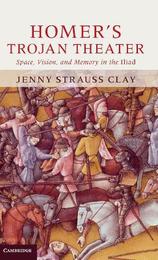
|
Homer's Trojan Theater: Space, Vision, and Memory in the IIiad
Hardback
Main Details
| Title |
Homer's Trojan Theater: Space, Vision, and Memory in the IIiad
|
| Authors and Contributors |
By (author) Jenny Strauss Clay
|
| Physical Properties |
| Format:Hardback | | Pages:146 | | Dimensions(mm): Height 220,Width 142 |
|
| Category/Genre | Literary studies - classical, early and medieval |
|---|
| ISBN/Barcode |
9780521762779
|
| Classifications | Dewey:883.01 |
|---|
| Audience | | Postgraduate, Research & Scholarly | |
|---|
|
Publishing Details |
| Publisher |
Cambridge University Press
|
| Imprint |
Cambridge University Press
|
| Publication Date |
10 February 2011 |
| Publication Country |
United Kingdom
|
Description
Moving away from the verbal and thematic repetitions that have dominated Homeric studies and exploiting the insights of cognitive psychology, this highly innovative and accessible study focuses on the visual poetics of the Iliad as the narrative is envisioned by the poet and rendered visible. It does so through a close analysis of the often-neglected 'Battle Books'. They here emerge as a coherently visualized narrative sequence rather than as a random series of combats, and this approach reveals, for instance, the significance of Sarpedon's attack on the Achaean Wall and Patroclus' path to destruction. In addition, Professor Strauss Clay suggests new ways of approaching ancient narratives: not only with one's ear, but also with one's eyes. She further argues that the loci system of mnemonics, usually attributed to Simonides, is already fully exploited by the Iliad poet to keep track of his cast of characters and to organize his narrative.
Author Biography
Jenny Strauss Clay is the William R. Kenan, Jr, Professor of Classics at the University of Virginia and the author of The Wrath of Athena: Gods and Men in the Odyssey (1983), an influential study of the Odyssey, The Politics of Olympus (1989), a groundbreaking study of the Homeric Hymns, as well as numerous articles on Greek and Roman poetry. Her book Hesiod's Cosmos (2003) offers a new and coherent synthesis of the Theogony and the Works and Days.
|